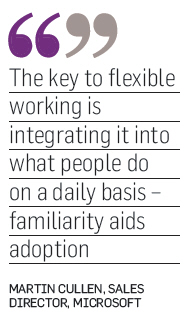Steven Goldblatt, managing director, Leaf Consultancy
There are few firms today that aren’t treading water and, you can imagine, suggesting to hard-pressed managers that flexible working might be the answer to their problems may be met with a flinty-eyed stare.
But it seems Microsoft is boldly pressing ahead with its vision to unlock productivity through flexibility and it is confident it has the results and the tools to prove it.
In the past year, the software giant unveiled its Lync unified communications technology, as well as its Office 365 cloud computing productivity suite.
As you can see from the arrival of devices like the Nokia Lumia 800, which is powered by Microsoft’s Windows Phone OS, there is a bridge between productivity today and the arrival of its next PC operating system Windows 8.
Allied with this is a drive to encourage businesses to redesign the structure of their premises to be more amenable to flexible working and collaboration, allowing workers to work from home and on the road and return to the office occasionally to brainstorm.
Productivity-processes link
Microsoft sales director Martin Cullen says there is a direct link between work processes and productivity growth which firms need and flexible or remote working, which many senior managers are resisting.
A report last month by Microsoft found that in 2010, Ireland had the least productivity growth in Europe, despite 80pc of workers working overtime each week and 40pc driving more than 10km to work each day.
According to Steven Goldblatt from Leaf Consultancy, firms are inevitably being drawn to new technologies and ways of working by workers’ expectations and, increasingly, regulatory compliance needs.
“One of the main drivers, I think, is regulatory but also I think because the recession has made people re-evaluate work processes and increasingly they want to work in an environment where they feel productive and happy.”
This, he says, is giving rise to concepts like free-desking and appreciation of how new ideas are being generated by simply sitting next to a different person.
“Until now, people struggled through trying to balance the stresses of work and home life, but to be more productive firms are realising they need to create work environments that actually take the stress out of everyday life,” Goldblatt explains.
Cullen notes that the knowledge base among senior management in Irish firms about flexible working is still quite low.
“It has to have leadership buy-in. It’s not going to work in an environment where people are expected to be at their desks from 9am.
“It’s just not about flexibility – it’s about productivity. Employers need to be able to get the best out of people.”
Goldblatt agrees: “The bottom line is that if a business is struggling, it is obvious it is not being as profitable as it once was. It has to try and get more out of its people in order to be more profitable. But as any business knows, you are only as good as the staff you have.”
Case in point: Law firm Tughans

Goldblatt points to the example of Northern Ireland law firm Tughans, which was one of the first law firms to issue partners with smartphones and an early adopter of virtualisation in the data centre.
The firm, which was founded in 1898 and prints out 150,000 pages a month, was able to achieve improved workflow by integrating SharePoint technology and CRM with its Exchange server, as well as rolling out Lync.
As well as improving internal communications, SharePoint was the key enabler for improved customer communications.
“It’s become a big factor in tenders,” says Tughans’ IT manager David Marley.
“Customers want to collaborate on documents and be able to access work in progress in real-time.
SharePoint has made this possible. They don’t need to ring us up or send an email, they just go online and log in.”
Goldblatt notes that once firms change the way they traditionally think and the idea gets buy-in from senior management, flexible, cloud-based working can deliver a significant return on investment.
“Individuals become more productive and it becomes easier to communicate and collaborate with clients.”
He adds that integration of technologies like SharePoint, CRM and Lync into the familiar setting of Outlook means the learning curve is less steep.
“At Tughans we piloted the technology with one department first and then expanded it to other departments one at a time. As soon as issues arose we easily ironed them out. Once the distribution process is well managed the rewards can be reaped much faster.”
Cullen concludes: “The key to flexible working is integrating it into what people do on a daily basis – familiarity aids adoption.
“Now, along with flexible working greater mobility is being enabled through platforms like Windows Phone, which integrates with workers’ Outlook as well as apps on Office 365, such as SharePoint online.
“The key is to identify the productivity benefits early on so the return is all the greater.”